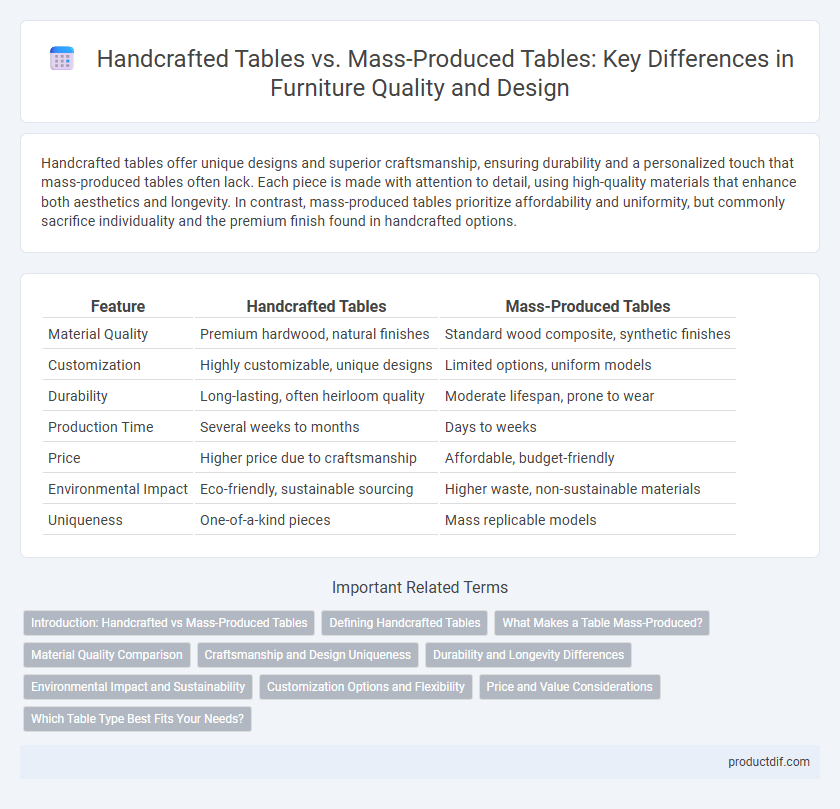Handcrafted tables offer unique designs and superior craftsmanship, ensuring durability and a personalized touch that mass-produced tables often lack. Each piece is made with attention to detail, using high-quality materials that enhance both aesthetics and longevity. In contrast, mass-produced tables prioritize affordability and uniformity, but commonly sacrifice individuality and the premium finish found in handcrafted options.
Table of Comparison
| Feature | Handcrafted Tables | Mass-Produced Tables |
|---|---|---|
| Material Quality | Premium hardwood, natural finishes | Standard wood composite, synthetic finishes |
| Customization | Highly customizable, unique designs | Limited options, uniform models |
| Durability | Long-lasting, often heirloom quality | Moderate lifespan, prone to wear |
| Production Time | Several weeks to months | Days to weeks |
| Price | Higher price due to craftsmanship | Affordable, budget-friendly |
| Environmental Impact | Eco-friendly, sustainable sourcing | Higher waste, non-sustainable materials |
| Uniqueness | One-of-a-kind pieces | Mass replicable models |
Introduction: Handcrafted vs Mass-Produced Tables
Handcrafted tables showcase unique artistry and superior craftsmanship, often made from premium, sustainably sourced wood with intricate detailing that highlights individual character. Mass-produced tables prioritize affordability and uniformity, utilizing automated manufacturing processes and standardized materials to achieve consistent quality at scale. Consumers seeking durability and personalized design typically prefer handcrafted options, while those valuing budget-friendly and readily available furniture lean towards mass-produced tables.
Defining Handcrafted Tables
Handcrafted tables are meticulously created by skilled artisans, emphasizing unique design, high-quality materials, and precise joinery that enhance durability and aesthetic appeal. These pieces often feature custom dimensions and intricate details that cannot be replicated by mass-production methods. The distinctive craftsmanship of handcrafted tables results in furniture that serves as both functional objects and artistic statements.
What Makes a Table Mass-Produced?
A mass-produced table is characterized by its assembly line manufacturing process, where standardized components are created in large quantities using machines and automated tools. These tables often prioritize cost-efficiency and uniformity, utilizing materials like engineered wood, laminates, or veneers to reduce production time and expenses. The emphasis on rapid production and consistent quality distinguishes mass-produced tables from handcrafted alternatives, which rely on individual craftsmanship and unique design elements.
Material Quality Comparison
Handcrafted tables utilize premium, sustainably sourced hardwoods such as walnut, oak, and maple, ensuring superior durability and unique grain patterns. Mass-produced tables often rely on engineered materials like MDF and particleboard, coated with veneers or laminates, resulting in lower longevity and susceptibility to damage. The material quality of handcrafted tables supports a higher resilience to wear and environmental changes compared to the uniform but less robust components found in mass production.
Craftsmanship and Design Uniqueness
Handcrafted tables showcase exceptional craftsmanship through meticulous attention to detail and use of high-quality materials, resulting in unique designs that reflect artisanal skill and creativity. Each piece is often customized, highlighting intricate joinery and finishes that are difficult to replicate in mass production. Mass-produced tables prioritize efficiency and uniformity, sacrificing design uniqueness and artisan techniques to meet larger-scale demand.
Durability and Longevity Differences
Handcrafted tables typically use high-quality hardwoods and joinery techniques that enhance durability, allowing them to withstand wear and tear over decades. Mass-produced tables often rely on engineered wood and adhesives, which may degrade faster under regular use, reducing longevity. The meticulous craftsmanship of handcrafted tables results in stronger, more resilient furniture that can be repaired and refinished, extending its lifespan significantly beyond mass-produced counterparts.
Environmental Impact and Sustainability
Handcrafted tables often use sustainably sourced wood and traditional techniques that minimize waste, resulting in a lower environmental footprint compared to mass-produced tables. Mass-produced tables typically rely on synthetic materials and chemical adhesives, contributing to higher carbon emissions and challenges in recyclability. Choosing handcrafted furniture supports sustainable forestry practices and reduces reliance on industrial manufacturing processes that generate significant pollution.
Customization Options and Flexibility
Handcrafted tables offer extensive customization options, allowing buyers to select specific wood types, finishes, dimensions, and intricate design details that reflect personal style and functional needs. Mass-produced tables typically come in standardized sizes and limited styles, prioritizing affordability and quick availability over individualized features. The flexibility of handcrafted tables supports unique spaces and preferences, while mass-produced alternatives focus on consistency and cost efficiency.
Price and Value Considerations
Handcrafted tables typically command higher prices due to the use of premium materials and skilled artisanship, offering unique designs and long-lasting durability. Mass-produced tables are more budget-friendly, benefiting from economies of scale but often sacrificing customization and material quality. Evaluating price against value requires considering longevity, craftsmanship, and the potential for personalized features inherent in handcrafted options.
Which Table Type Best Fits Your Needs?
Handcrafted tables offer unique designs, superior craftsmanship, and customizable options, making them ideal for those seeking personalized, durable furniture with distinct character. Mass-produced tables provide affordability, wide availability, and consistent quality, suited for budget-conscious buyers or those needing quick, standard solutions. Choosing the best table depends on priorities like budget, design preference, and long-term value.
Handcrafted tables vs Mass-produced tables Infographic

 productdif.com
productdif.com